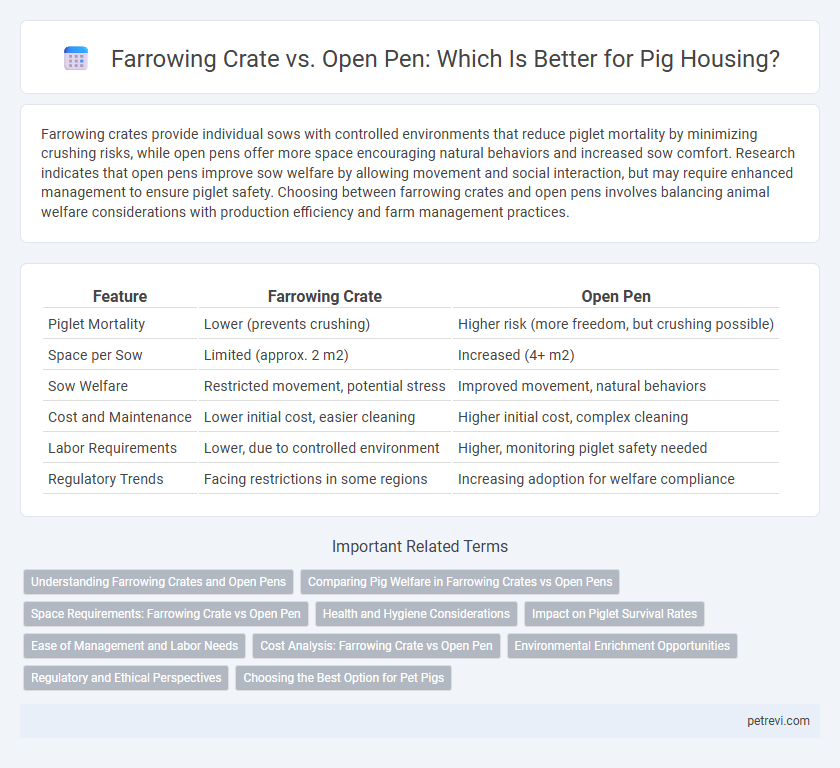Farrowing crates provide individual sows with controlled environments that reduce piglet mortality by minimizing crushing risks, while open pens offer more space encouraging natural behaviors and increased sow comfort. Research indicates that open pens improve sow welfare by allowing movement and social interaction, but may require enhanced management to ensure piglet safety. Choosing between farrowing crates and open pens involves balancing animal welfare considerations with production efficiency and farm management practices.
Table of Comparison
| Feature | Farrowing Crate | Open Pen |
|---|---|---|
| Piglet Mortality | Lower (prevents crushing) | Higher risk (more freedom, but crushing possible) |
| Space per Sow | Limited (approx. 2 m2) | Increased (4+ m2) |
| Sow Welfare | Restricted movement, potential stress | Improved movement, natural behaviors |
| Cost and Maintenance | Lower initial cost, easier cleaning | Higher initial cost, complex cleaning |
| Labor Requirements | Lower, due to controlled environment | Higher, monitoring piglet safety needed |
| Regulatory Trends | Facing restrictions in some regions | Increasing adoption for welfare compliance |
Understanding Farrowing Crates and Open Pens
Farrowing crates are designed to restrict sow movement to prevent piglet crushing, offering controlled environments with individual feeding and easy monitoring but raising animal welfare concerns due to limited freedom. Open pens provide sows with more space and freedom to move, promoting natural behaviors and improving welfare, yet they require more management effort to ensure piglet safety and may increase piglet mortality risks. Understanding the trade-offs between farrowing crates and open pens involves balancing piglet survival rates, sow welfare, and operational efficiency in pig housing systems.
Comparing Pig Welfare in Farrowing Crates vs Open Pens
Farrowing crates restrict sow movement to reduce piglet mortality but often compromise sow comfort and natural behaviors, leading to increased stress and welfare concerns. Open pens allow greater sow mobility and expression of natural behaviors such as nest-building, enhancing maternal welfare despite a potentially higher risk of piglet crushing. Balancing piglet safety with sow welfare requires optimizing design features in both systems to promote natural behaviors while minimizing mortality rates.
Space Requirements: Farrowing Crate vs Open Pen
Farrowing crates require significantly less space per sow, typically around 1.5 to 2.0 square meters, compared to open pens that need 4 to 6 square meters to allow movement and nesting activities. Open pens accommodate natural behaviors such as turning and nesting, necessitating larger spatial dimensions to ensure sow comfort and piglet safety. Optimal space allocation in pig housing directly influences sow welfare and piglet survival rates, making spatial design a critical component of farrowing system choice.
Health and Hygiene Considerations
Farrowing crates reduce piglet crushing incidents by restricting sow movement, which helps maintain cleaner piglet environments and minimizes the spread of infections. Open pens promote better ventilation and natural behaviors, decreasing respiratory issues and improving overall hygiene through increased space and waste dispersion. Both systems require diligent sanitation practices to prevent disease, but farrowing crates offer more controlled conditions to isolate sick animals and manage infection risks effectively.
Impact on Piglet Survival Rates
Farrowing crates provide individual confinement that significantly reduces piglet crushing rates, enhancing survival during the critical first days post-birth. Open pens allow greater sow movement and natural behavior expression, which can improve sow welfare but may increase piglet mortality due to accidental crushing. Research indicates piglet survival rates tend to be higher in farrowing crates compared to open pen systems, especially in intensive production environments.
Ease of Management and Labor Needs
Farrowing crates enable easier monitoring and intervention during the sow's birthing process, reducing labor intensity due to confined spaces that limit sow movement. Open pens require more labor for managing sow and piglet interactions, as workers must navigate larger areas and increased risk of piglet injury. Overall, farrowing crates streamline tasks such as feeding, cleaning, and piglet care, leading to more efficient management compared to open pen systems.
Cost Analysis: Farrowing Crate vs Open Pen
Farrowing crates have higher initial costs due to specialized materials and design but reduce piglet mortality through controlled movement, potentially lowering overall expenses. Open pens offer lower construction and maintenance costs but may increase piglet losses and labor needs, impacting profitability. Evaluating total cost including piglet survival rates and labor efficiency is essential for determining the more economical pig housing system.
Environmental Enrichment Opportunities
Farrowing crates limit environmental enrichment opportunities for sows by restricting natural behaviors such as rooting, nest-building, and exploring, which can increase stress and reduce welfare. Open pens provide enhanced enrichment potential through the inclusion of substrates, chewable materials, and increased space, promoting physical activity and mental stimulation. Research shows that enriched environments in open pens contribute to improved sow well-being and piglet survival rates.
Regulatory and Ethical Perspectives
Farrowing crates, regulated in many regions for minimizing piglet mortality, face ethical scrutiny due to restricted sow movement, prompting some countries to implement bans or stricter welfare standards requiring more space and freedom. Open pens enhance animal welfare by allowing natural behaviors, aligning with evolving legal frameworks such as the EU Pig Directive that mandate enriched environments and reduce confinement. Regulatory trends increasingly favor systems balancing piglet safety with sow welfare, reflecting consumer demand for ethically responsible pig housing solutions.
Choosing the Best Option for Pet Pigs
Farrowing crates provide enhanced protection for piglets by limiting the sow's movement, reducing the risk of crushing incidents, which is crucial for first-time or high-risk mothers. Open pens offer more space and freedom, promoting natural behaviors and improving sow welfare, suitable for experienced mothers and pet pigs with attentive care. Choosing the best option depends on balancing piglet safety, sow comfort, and the owner's ability to monitor and intervene when necessary.
Farrowing crate vs Open pen for Pig housing Infographic

 petrevi.com
petrevi.com